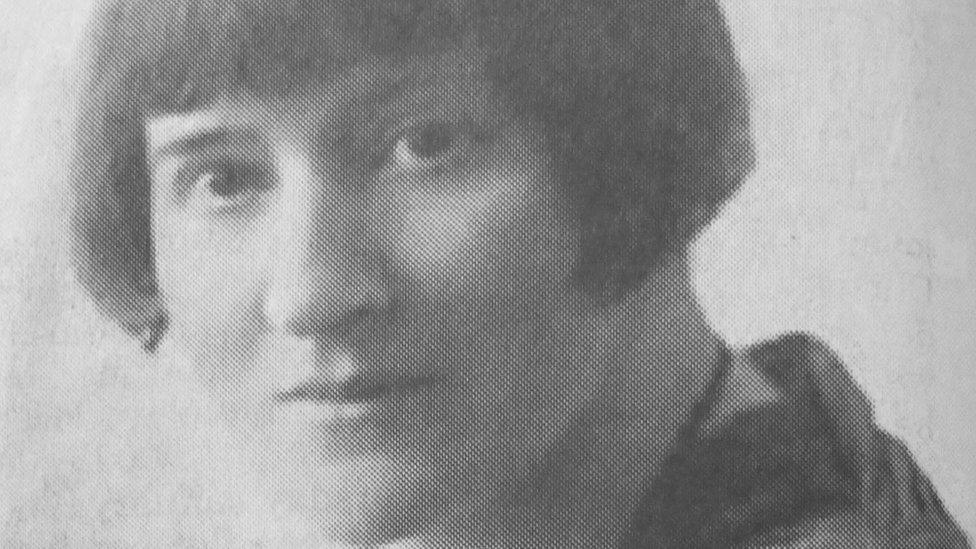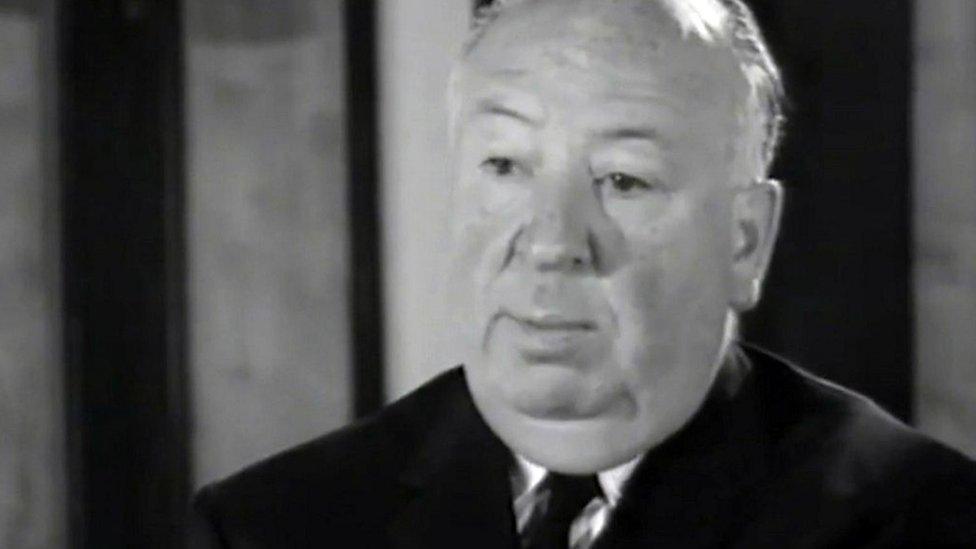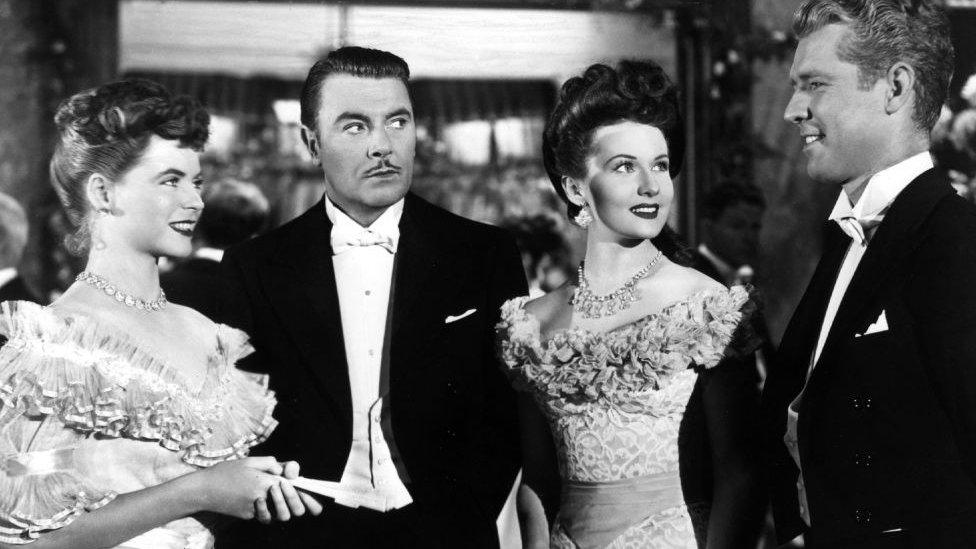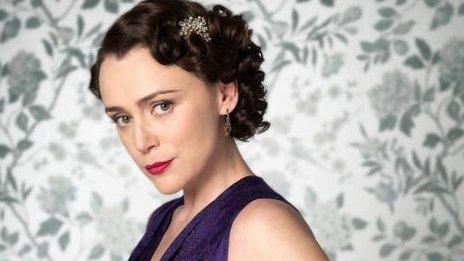Ethel Lina White: The Abergavenny writer who inspired Hitchcock
- Published

Ethel Lina White had three of her novels adapted for the big screen
She was favourably compared to Edgar Allan Poe, Agatha Christie and Dorothy L Sayers.
Crime writer Ethel Lina White even aided revered British director Alfred Hitchcock when his film based on one of her books helped him launch his Hollywood career.
Yet nearly 80 years after her death, she appears to be remembered by few.
Now a group of historians hope to share the story of the little known writer whose work inspired Hollywood movies.
A QR code will be installed close to the blue plaque in her birthplace in the Monmouthshire town of Abergavenny, to help people learn interactively about her life.
Ethel was born in Frogmore Street in 1876, to builder William White and his wife Eliza, in the building which is now the Serendipity hair salon.
Although the house of her birth shows her modest beginnings, while Ethel was still a child the family's fortunes would be transformed.
Dr Gill Wakley, who chairs the Abergavenny history society, said: "Her father invented Heigia Rock, a compound of bitumen and cement.
Genesis of her brilliance
"It was the first waterproof building material, coming just in time for use in the construction of the London Underground, and it made him a prosperous man."
Sheffield Hallam student Alex Csurko, who is embarking on a PhD into Ethel, believes her father's invention may have been the genesis of her brilliance.
He speculated that had William been an ordinary builder then the odds were that Ethel would have had to have been married off, simply to remove her from the family's expenses.

The Lady Vanishes was Hitchcock's last British-made film
"We know from the 1911 census that, aged 35, she was still living at home with her parents - by which time she'd already had dozens of poems and short stories published in the press - over 100 in her lifetime," he said.
Her earliest known work was published in an 1899 edition of Hearth and Home - a poem called Lines on Oliver Cromwell's Bust.
"The house which William built on the back of his invention - Fairlea Grange on Belmont Road - shows how much she was brought up in a literary household, inspiring her to write works like Some Must Watch as she grew up with images of Walter Scott's novels in the drawing room, and other figures from literature throughout the property, including Charles Kingsley's Water Babies in one of the bedrooms," Mr Csurko added.
Records show that by 1917 Ethel was working in London in the Ministry of Pensions, and Mr Csurko believes this is possibly where her career really took off.
"The amazing thing about Ethel is that, despite writing all her life, she wasn't truly recognised until she was in her 60s," he said.
"Maybe it took her move to London before she was introduced to the right people?"
'Lack of fresh air'
Possibly pressured to give up her job by the need to find work for returning servicemen from World War One, in 1919 she quit for a £10 advance to write short stories for newspapers.
Either way, she later told reporters she handed in her notice because she couldn't stand "the lack of fresh air and office life".
By 1927 she had her first full-length novel published, and a year later she was in the West End with a play, The Port of Yesterday.
By 1938 she hit stardom when Alfred Hitchcock chose to adapt her detective thriller The Wheel Spins - about a young woman on a train and her missing companion - into his film The Lady Vanishes.
Mr Csurko said this was where the acclaimed director's and Ethel's paths first crossed.
"My dissertation for my undergraduate degree was on Alfred Hitchcock," he said.
"The Lady Vanishes was Hitchcock's last British-made film, and I think it's fair to say it was the one which made Hollywood studios sit up and take notice of him.
"From then on it fascinated me as to why she wasn't better known."

Ethel Lina White's novel Some Must Watch was released on film in 1946 as The Spiral Staircase
Ethel would have two more of her novels adapted for the big screen - Midnight House was filmed as The Unseen, and The Spiral Staircase was based on her novel Some Must Watch.
However, while the legacy of other writers such as Agatha Christie have lived on, Ethel's reputation has faded into the background.
"I think there is an easy explanation for this," said Mr Csurko. "Ethel simply wasn't prepared to play the fame game which made stars of other writers.
"In an interview with critic Peter Cheyney, she said: 'I was not born. I have never been educated and have no tastes or hobbies. This is my story and I'm sticking to it'."
He said that in many reviews, Ethel was alternately described as "spikey", "witty" and "sarcastic".
As well as being difficult to get on with, he hypothesises the fact she was not published until her 60s has counted against her legacy.
"She was brilliant in her own time, but when you consider the likes of Agatha Christie started a decade before her and carried on until the 70s, there's just not the volume of work to compare them fairly," Mr Csurko said.
However, he strongly disagreed with fellow academics such as Malcom Turnbull, who wrote: "Ethel Lina White has nothing new to add to the detective genre".
Mr Csurko said: "This is massively unfair.
"She took a style in its infancy and added so many threads of classical literature to it - for example her first detective novel, Put Out The Light is a direct reference to Othello."
Ethel died of ovarian cancer in 1944. Intriguingly, and quite macabrely, her will demonstrated her lifelong fear of being buried alive, which can be read in her 1935 novel The First Time He Died.
The will read: "I give and bequeath unto Annis Dora White [her sister] all that I possess on condition she pays a qualified surgeon to plunge a knife into my heart after death."
The QR codes are part of the HistoryPoints project, which aims to help the public learn about the history of local places with QR codes which can be scanned on smart devices.

BACKYARD BREEDERS: Breaking the law in brutal designer dog trade worth tens of thousands of pounds
STORIES FROM WALES : Documentaries for curious minds

Related topics
- Published17 August 2012
